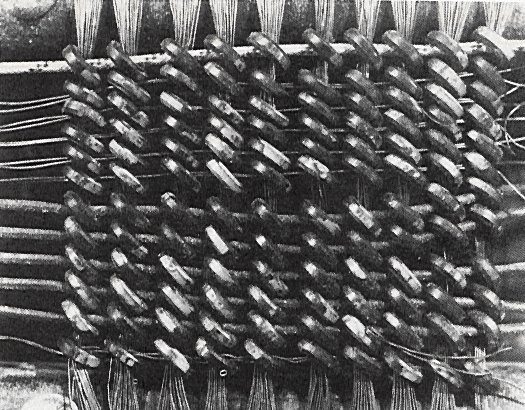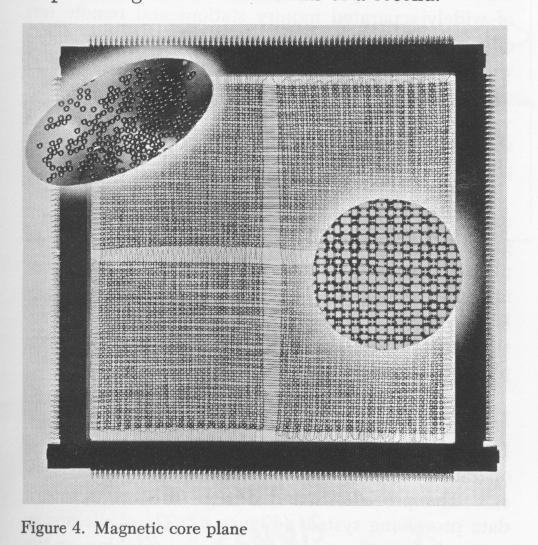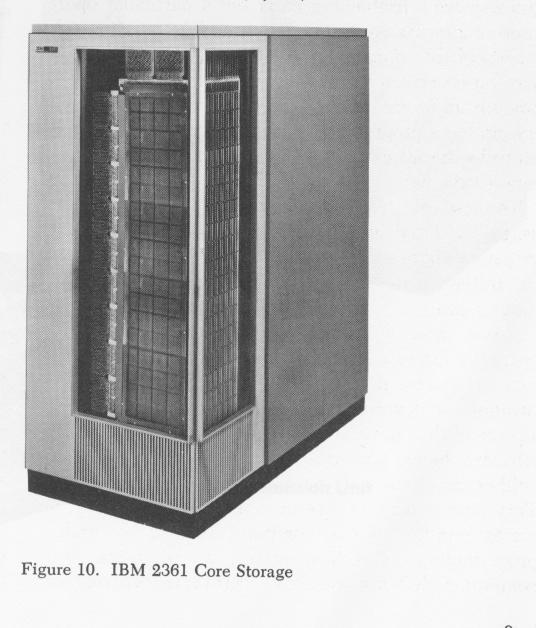**********************************************

IBM 650 Magnetic Drum
Now this was THE Storage Device for Data ****AND **** the instructions ****to be executed.....
I wrote a calculartion program for it ....
SOAP language (Assembler ) and...Fortran.
Posted on 01/13/2012 6:52:59 AM PST by Ernest_at_the_Beach
Cuts bit size down to 12 atoms
I remember the PDP8. I remember having to load the boot code from the switch registers, then booting from paper tape. Our college “small computer lab” also had a PDP-5.
It’s a rather humbling experience to look back in time and then see where we sit in today’s world of technologies across the wide spectrum.
Our PDP-8 was equipped with a fixed-head (head-per-track) disk with 32K word (48K byte) capacity. At least it was fast, because of no head positioning time, just rotational latency. It filled 10.5” of vertical rack space.
“Files” were just address ranges of words on the disk, which we kept track of manually.
We also bought an expansion box of magnetic core memory, expanding the computer from its native 4K words all the way up to 12K words! It cost us $7000.
The USCGA in New London, CT still has a working PDP-11. It did back in 2005, I believe.
When our department finally got permission to acquire its own data processing computer, we got a 360/22 (a stripped-down reconditioned 360/30). We got Telex tape drives and 2311-equivalent disks. And a real IBM 1403 printer.
I wrote my first (and undoubtedly only) PL/I program on that Beest.
I had a 370/168 and 7 3031-AP’s (a 3033 with channels attached to 1 cpu side only) .... I loved the operator consoles used on those.. .... had screen burn clear to the 100% mark for all channels and processors.
Not as far back as the 8" but I still remember when 740k per side was the Bee's Knees.
I still have T-shirts (My HHGTTG "I Got The Babel Fish" shirt for one) with drool stains on them...deposited whilst I was dreaming of owning my first hard drive.
**********************************************

IBM 650 Magnetic Drum
Now this was THE Storage Device for Data ****AND **** the instructions ****to be executed.....
I wrote a calculartion program for it ....
SOAP language (Assembler ) and...Fortran.
This is starting to get ridiculous. Next someone will claim that he worked on an original Babbage Difference Engine.
The drum was before my time, but we heard stories about it. One story related to what happened when one unit experienced a bearing failure at a nearby college. The drum itself was a metal cylinder 4 inches in diameter and 16 inches long, spinning at 12,500 rpm. You can imagine the kinetic energy. The story had it that when the bearing failed, the drum came out of the housing, flew across the room, went THROUGH the wall, and embedded itself in the wall of the next room.
It shows the huge changes over the decades. That 7 1/2 MB 2311 drive that I talked about was still in use in the mid 1970's, not long ago in human years, but eons ago in terms of computer generations.

IBM 1301 disk storage unit
The had TWO R/W heads
For all of the disks.....
The IBM 1301 Disk Storage Unit was announced in June 1961 and used with the 7000 series of IBM mainframes and with the IBM 1410 Data Processing System. As many as five 1301 units could be attached to a computer system to provide a maximum storage capacity of 280 million characters for the 7000 series and 250 million for the 1410.
Well, in all fairness to those of us who starting using FORTRAN with -66... your FORTRAN was, what, FORTRAN-II or something?
I don’t think you even had named COMMON blocks back then....

Above: The first magnetic core memory, from the IBM 405 Alphabetical Accounting Machine. The photo shows the single drive lines through the cores in the long direction and fifty turns in the short direction. The cores are 150 mil inside diameter, 240 mil outside, 45 mil high. This experimental system was tested successfully in April 1952.

Of course IBM 360 core memory was much more advanced and denser. The photo shows a magnetic core plane of the type used in the 360.

The IBM 2361 Core Storage Module housed 16K bytes of core memory. You can see the core planes (and the individual cores, i.e. bits) through the glass doors.

Core memory diagram, illustrating coincident current selection. The half-select current applied through the indicated vertical and horizontal lines are each too small to switch the cores through which they pass. The one core in the center of the figure is switched, however, by the coincidence of the two currents. A former IBM employee tells me that when IBM first decided to manufacture core memory, they consulted with the Lifesaver company on fabrication methods.
Allen J. Palmer adds (March 2005): "I am part of the Computer History Museum 1401 Restoration Project team (729's being my area for this project). I was looking at your web page on core memory. Do you have a page with the full diagram of the core wiring layout. There were 4 wired passing through each 'donut' -- X & Y plus the read wire which sensed the flip of the core at read out by the magnetic field developed when the core flipped & that field 'cut' the read wire & inducted an 'electrical impulse' which was then amplified and became the 'read out data'. A 4th wire was the 'inhibit' wire used prevent some core from flipping' I have an old 4k 1401 memory core sitting out on my work bench gathering dust for the last 25 years. Someday I need to clean it up & build a case with a light & a magnifying glass so people can see how we did it in the 'old days'."
Most recent update: Tue Sep 28 10:23:29 2010
Links:
I filed a patent in the mid 80's on an advanced chip-making technique. The patent office denied the patent based on an patent (3 actually) awarded to IBM in the mid 60's. (for crying out loud)
I got a quote on iron-core memory in the late 1970s from IBM at $1.75 million ... per megabyte.
A year ago I bought a gigabyte of RAM for about $50.
A 30-million-fold decrease in price.
Disclaimer: Opinions posted on Free Republic are those of the individual posters and do not necessarily represent the opinion of Free Republic or its management. All materials posted herein are protected by copyright law and the exemption for fair use of copyrighted works.